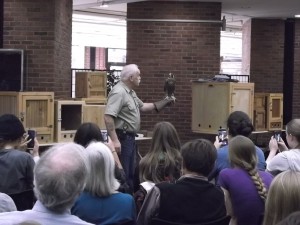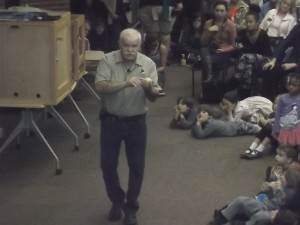I read recently in one of our local newspapers that the Norcross Wildlife Sanctuary would again be hosting a series of winter lectures; today’s topic, “Conserving the Timber Rattlesnake in Massachusetts,” sounded very interesting, so I emailed the Foundation to sign up (the lecture space is not large, so they need to have a sense of how many people will attend).
Sanctuary naturalist Jennifer Ohop introduced the speaker, Anne Stengle, a doctoral candidate at the University of Massachusetts, Amherst, to a capacity crowd of almost eighty people. Fascinated by reptiles since her childhood, Ms Stengle has been studying the timber rattlesnake since 2009. She outlined her talk for us: she would discuss (1) what a rattlesnake is, (2) the snake’s life history and traits, (3) conservation issues and trends, and (4) the status of the Quabbin project.
There are between fourteen to twenty species of rattlesnake in the United States (the number depends on who’s counting, as how to define a species is not mathematically precise). Rattlesnakes (all except one species) have rattles at the ends of their tails; these are bony segments which grow as the snake grows (older snakes have more segments). Rattlesnakes all have a pit organ, which senses heat, and a bifurcated tongue. The pit organ is connected to the optic nerve, which enables them to “see” infrared. Rattlesnakes are ambush predators which eat mostly small mammals. And, of course, they are venomous. Their venom is for acquiring prey — it allows the snake to immobilize the prey and then because the venom is hemotoxic, to digest it. Due to the wide availability of snake anti-venin and modern transportation options, a bite from a rattlesnake is rarely life-threatening. That said, a rattlesnake bite is a serious medical emergency and should be treated as such. Folk remedies such as whisky will NOT be effective.
Researchers must be trained to work safely with snakes; they use tools such as snake hooks and tongs to capture them, and snake tubes and bags to hold them safely. The intent is to keep the snake’s head away from the person, in order to avoid getting bitten.
Endemic to the New World, meaning North, Central, and South America, rattlesnakes are now endangered or extinct in all six New England states. A number of factors contributed to their decline: habitat loss due to development and logging, the popularity of rattlesnake products, and poaching. The timber rattlesnake, Crotalus horridus, has an average length of 1.5 meters, and is mature at 10 years. It only reproduces every 3 years, or even 3 to 5 years. These snakes can live to be 20, 30, or even 40 years old! They have different color patterns, including a yellow morph and black morph. Each year, the rattlesnake lives through two seasons, an active season which begins around May, and then an overwintering season starting in September, when the snakes enter their dens, or hibernacula. These snakes, by the way, give birth to live young.
Rattlesnakes are widely dispersed over the North American continent, from New England westward to Minnesota and southward to Oklahoma. In New England, their small and declining numbers are due to fragmented populations, poor management, and disease. To address this decline, conservation strategies have been developed that focus on translocating individuals, population supplementation, and head-starting (in addition to habitat management).
In her academic work, Ms Stengle studied the rattlesnake’s population genetics. A decrease in genetic variation is problematic, she explained, because it leads to more mutations and compromised immune systems, which adversely affect survival rates. Her research objectives are to study the genetic diversity of the timber rattlesnake in the Northeast, to study movement patterns, and to perfect the mark-and-recapture technique. She and her colleagues use radio telemetry, which means they capture the specimens and surgically implant radio transmitters. She also does DNA analysis, using shed skin, blood, and scales (the DNA analysis is done with the PCR, or polymerase chain reaction, technique).
This genetic analysis of the Massachusetts rattlesnake populations showed some interesting results. For example, one can plot geographic distance vs genetic distance for different snake populations, and one would expect a more or less linear relationship. But this is not the case for the timber rattlesnake. Instead, the populations are very distinct, even if they are not widely separated geographically (example, Berkshires vs Blue Hills).
Ms Stengle and her colleagues also expended a good deal of effort on studying the effects of SFD (Snake Fungal Disease), first described in 2009, on snake populations. Attributed to the Ophidiomyces ophiodiicola fungus, it is not a new disease; rather, it is broadly observed (noted in at least 17 species) and its severity varies. In a radiotelemetry study of infected and non-infected populations, researchers noted their movement and basking behavior and also took biopsies of individuals. To their relief, they discovered that although around 61% were O.o. positive, the disease did not seem to impede the snake’s ability to find food or to mate. In fact, many of the lesions disappeared when the snakes shed their skins. Ongoing research into SFD will include conducting disease transmission studies, trying experimental treatments, taking biopsies, and continuing population monitoring.
Interest in the timber rattlesnake in Massachusetts reached a fever pitch recently when details of a plan to establish a colony on Mt Zion in the Quabbin Reservoir became more widely known by the general public. Predictably, due to a human fear and dislike of snakes, the reaction was mostly negative, and the project will not move ahead on the original schedule. Instead, a Working Group has been established to debate the pros and cons of the plan and present the findings to the Legislature.
The original idea was to establish a self-sustaining colony of timber rattlesnakes in an area where human threats to the population would be minimized. As it is a drinking water reservoir, many areas of the Quabbin are restricted anyway, and Mt Zion, at 560 acres, and with a 856 foot elevation, seemed ideal. Although it is not known if historically rattlesnakes were found here, there are at least three sites on the island that look like good snake habitat. In conjunction with the Roger Williams Providence Zoo, the plan was to use captive bred and wild-caught neonates, head-start the snakes at the Zoo, then release them when they weigh 250+ grams (a snake of this size can safely be implanted with a radio device). The first release was planned for Spring 2017, with a goal of 100-150 individuals in the population over the next twenty years.
Ms Stengle concluded by emphasizing the importance of timber rattlesnake conservation. She pointed out that the rattlesnake has cultural significance to Americans, being a species that the early colonists had not known in Europe and appearing as a symbol of American defiance of tyranny on early flags. For more information on the status of this species in our state, please read this summary from the DFW.

